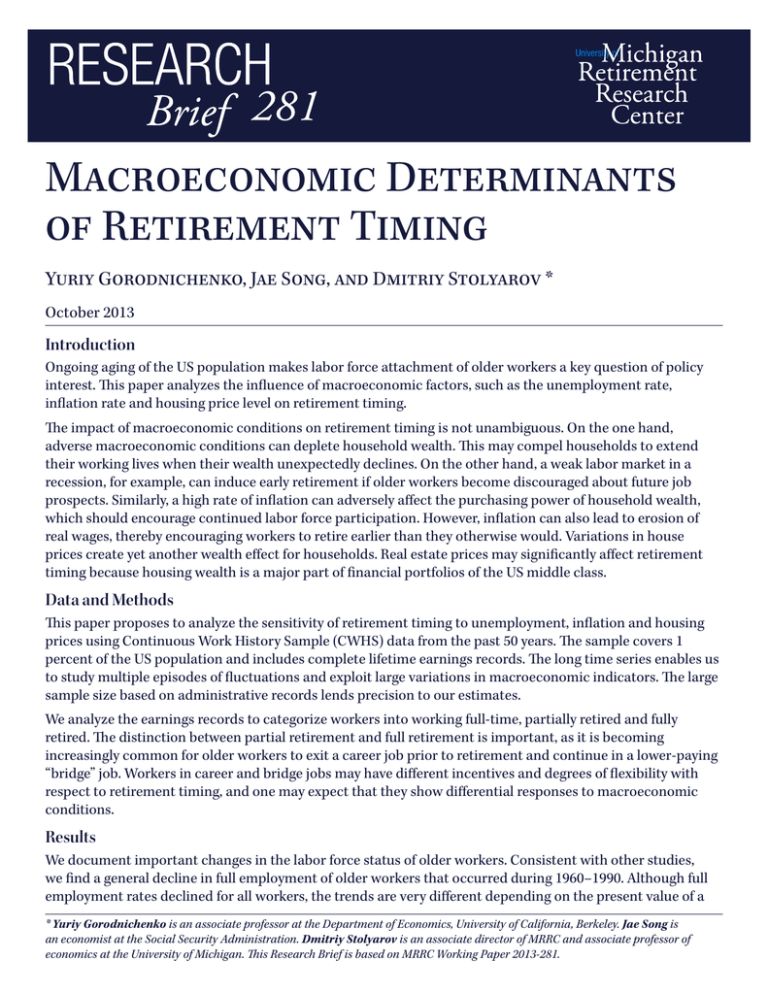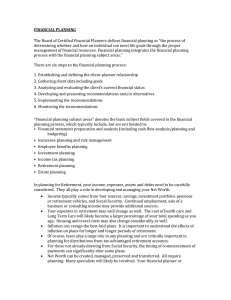Macroeconomic Determinants of Retirement Timing
advertisement

Macroeconomic Determinants of Retirement Timing Yuriy Gorodnichenko, Jae Song, and Dmitriy Stolyarov * October 2013 Introduction Ongoing aging of the US population makes labor force attachment of older workers a key question of policy interest. This paper analyzes the influence of macroeconomic factors, such as the unemployment rate, inflation rate and housing price level on retirement timing. The impact of macroeconomic conditions on retirement timing is not unambiguous. On the one hand, adverse macroeconomic conditions can deplete household wealth. This may compel households to extend their working lives when their wealth unexpectedly declines. On the other hand, a weak labor market in a recession, for example, can induce early retirement if older workers become discouraged about future job prospects. Similarly, a high rate of inflation can adversely affect the purchasing power of household wealth, which should encourage continued labor force participation. However, inflation can also lead to erosion of real wages, thereby encouraging workers to retire earlier than they otherwise would. Variations in house prices create yet another wealth effect for households. Real estate prices may significantly affect retirement timing because housing wealth is a major part of financial portfolios of the US middle class. Data and Methods This paper proposes to analyze the sensitivity of retirement timing to unemployment, inflation and housing prices using Continuous Work History Sample (CWHS) data from the past 50 years. The sample covers 1 percent of the US population and includes complete lifetime earnings records. The long time series enables us to study multiple episodes of fluctuations and exploit large variations in macroeconomic indicators. The large sample size based on administrative records lends precision to our estimates. We analyze the earnings records to categorize workers into working full-time, partially retired and fully retired. The distinction between partial retirement and full retirement is important, as it is becoming increasingly common for older workers to exit a career job prior to retirement and continue in a lower-paying “bridge” job. Workers in career and bridge jobs may have different incentives and degrees of flexibility with respect to retirement timing, and one may expect that they show differential responses to macroeconomic conditions. Results We document important changes in the labor force status of older workers. Consistent with other studies, we find a general decline in full employment of older workers that occurred during 1960–1990. Although full employment rates declined for all workers, the trends are very different depending on the present value of a * Yuriy Gorodnichenko is an associate professor at the Department of Economics, University of California, Berkeley. Jae Song is an economist at the Social Security Administration. Dmitriy Stolyarov is an associate director of MRRC and associate professor of economics at the University of Michigan. This Research Brief is based on MRRC Working Paper 2013-281. worker’s lifetime earnings. For example, the recent full-time employment rate for 60 year olds in the bottom earnings quintile is just 40 percent, which is 1.5 times less than average for their age group, and for 65 year olds in the bottom earnings quintile, it is 20 percent, which is 2 times less than their age group average. On the other hand, the 65–67 year old workers in the top quintile of earnings exhibit a full-time employment trend that diverges from the rest of the population. While average full-time employment rates stayed relatively stable since 1990, the full-time employment rate for 65–67 year old top earners bottomed out in the 1990s and has been rising since, suggesting longer careers for this group. At the same time, partial retirement has been on the rise across all age and income groups. While partial retirement was virtually non-existent for 60–62 years olds in 1960, over the past 20 years more than 15 percent of workers in this age group are categorized as partially retired. For 65–67 year olds, the recent partial retirement rate is over 20 percent, up from 5–10 percent in 1960. We analyze the influence of macroeconomic indicators on the timing of partial and full retirement for 55–75 year old workers. Our econometric specification is non-parametric in that it estimates sensitivity parameters separately for each age. We find robust evidence that flows from full employment to both partial and full retirement rise significantly in recessions. Workers near the normal retirement age (63–67 years old) are especially sensitive to changes in the national unemployment rate. We estimate that a 1 percent rise in the national unemployment rate leads to about 1 percent drop in the full employment rate of all 55–75 year olds, with the full employment rate among the 63–67 age subgroup dropping as much as 2 percent. The same 63–67 age subgroup experiences the most increase in the flow into partial and full retirement associated with recessions. The response to unemployment is different for workers who are partially retired. When the unemployment rate is high, partially retired workers younger than 63 actually extend their partial retirement spell while those older than 63 accelerate their transition to full retirement. Somewhat surprisingly, we find that high inflation is associated with exit from the labor force, through partial as well as full retirement. One explanation for this may be that during high inflation episodes wages do not keep up with inflation, and lower real wages discourage labor force participation. Our results also indicate that housing prices do not have a significant effect on retirement timing. This agrees with the results in the previous literature finding that the rate of return on financial assets does not significantly impact retirement timing. Our result suggests that either the wealth effects associated with housing prices are small or that housing price increases are correlated with other macroeconomic variables that encourage labor force participation. We further investigate whether retirement timing of wealthier workers is less sensitive to changes in macroeconomic conditions (we use the present value of lifetime earnings as a proxy for wealth). One would expect that wealthy individuals have more control over their retirement timing either because of their high resources or because of more flexible careers in high-paying occupations. We find that retirement decisions of wealthy workers are only marginally less sensitive to macroeconomic conditions. The sensitivity of retirement transitions to the unemployment rate and inflation is quite similar across lifetime earnings quintiles, with the 63–67 year old age group in every quintile responding most to changes in the unemployment rate. University of Michigan Retirement Research Center Institute for Social Research 426 Thompson Street Room 3026 Ann Arbor, MI 48104-2321 Phone: (734) 615-0422 Fax: (734) 615-2180 mrrc@isr.umich.edu www.mrrc.isr.umich.edu The research reported herein was performed pursuant to a grant from the U.S. Social Security Administration (SSA) through the Michigan Retirement Research Center (MRRC). The findings and conclusions expressed are solely those of the author(s) and do not represent the views of SSA, any agency of the federal government, or the MRRC. Regents of the University of Michigan: Julia Donovan Darlow, Laurence B. Deitch, Denise Ilitch, Olivia P. Maynard, Andrea Fischer Newman, Andrew C. Richner, S. Martin Taylor, Katherine E. White, Mary Sue Coleman, Ex Officio





